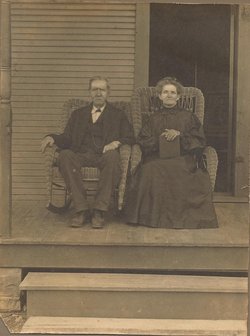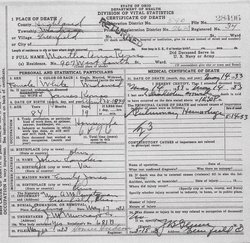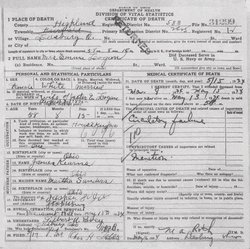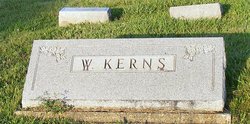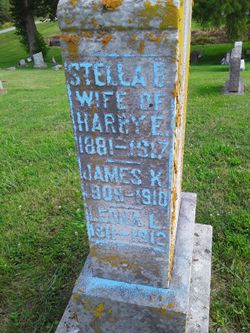| Description |
: |
James Kerns was the son of John Kerns 2nd and Rachel Merriman Kerns. His first marriage was to Elizabeth Belle Huffman born 1845 in Ohio, the daughter of Humphrey Huffman and Catherine Keplinger Huffman. He and Miss Huffman were married 3/31/1860 in Highland Co., Ohio. They had no children and divorced shortly after. She went to Nebrasks and nothing further is known.
Civil War Information
Name: James Kerns
Enlistment Date: 20 February 1862
Distinguished Service: DISTINGUISHED SERVICE
Side Served: Union
State Served:...
Read More
|
James Kerns was the son of John Kerns 2nd and Rachel Merriman Kerns. His first marriage was to Elizabeth Belle Huffman born 1845 in Ohio, the daughter of Humphrey Huffman and Catherine Keplinger Huffman. He and Miss Huffman were married 3/31/1860 in Highland Co., Ohio. They had no children and divorced shortly after. She went to Nebrasks and nothing further is known.
Civil War Information
Name: James Kerns
Enlistment Date: 20 February 1862
Distinguished Service: DISTINGUISHED SERVICE
Side Served: Union
State Served: Ohio
Unit Numbers: 1692
Service Record: Promoted to Full Sergeant
Enlisted as a Private on 20 February 1862
Enlisted in Company D, 11th Cavalry Regiment Ohio on 20 February 1862.
Regiment: 11th Cavalry Regiment OH
Date Mustered: Co. D 4.1.1865 Omaha, Neb. (End of enlistment)
Regiment Type: Cavalry
Enlisted Died of Disease or Accident: 3
Officers Died of Disease or Accident: 20
Enlisted Killed or Mortally Wounded: 1
Regimental Soldiers and History: List of Soldiers
Regimental History
OHIO
ELEVENTH CAVALRY
(Three Years)
Eleventh Cavalry. - Lieut.-Cols., William O. Collins, Thomas L. Mackey; Majs., John O. Ferrell, Bolivar C. Converse, Levi G. Marshall, William H. Evans. Cos. A, B, C and D of this regiment were organized as the 7th Ohio cavalry, but were consolidated on Dec. 19, 1861,
with the 6th cavalry, forming the 1st battalion of that regiment, the whole being then rendezvoused at Camp Dennison. On March 13, 1862, the 1st battalion, under command of Lieut.-Col. Collins, was detached from the 6th cavalry and ordered to report to Gen. Halleck, at St. Louis, Mo., by whom it was ordered to proceed to Fort Laramie, D. T. (now Wyoming) , where it arrived on May 30, 1862, having marched overland from Fort Leavenworth, Kan., a distance of about 640 miles. During the summer of 1862, the battalion was permanently detached from the regiment and designated as the "First Independent Battalion Ohio Volunteer Cavalry." A battalion of four companies (E, F, G and H) was organized at Camps Dennison and Chase, Ohio, from June 26 to July 31, 1863, when the two battalions were consolidated and designated the 11th Ohio cavalry. The 2nd battalion was called into service during John Morgan's raid through Ohio, and after the capture and dispersion of his force returned to Camp Dennison. Leaving Camp Dennison on Aug. 1, 1863, it reached Fort Leavenworth, Kan., on
the 13th. While there awaiting supplies the sacking and burning of the town of Lawrence occurred and the battalion was sent in pursuit of Quantrill. After marching about 150 miles it was recalled, and on Sept. 2 proceeded across the plains for Fort Laramie, where it arrived on Oct. 10. Cos. I, K and L were organized on June 30, 1864, at Fort Laramie, D. T., being composed of surplus recruits assigned to the regiment. The ground of the operations of this regiment, which was never actually together during its term of service, was in the center of the Rocky mountains and the then hostile Indian country, before the organization of the territory of Wyoming, when nearly all that vast extent of territory was known as Dakota and Idaho. Its principal duty was to guard the Pacific telegraph line and the overland route of communication and supply, extending from Colorado and western Nebraska and Kansas through Wyoming and Idaho to Utah and Oregon. With the exception of Fort Laramie, the men of this regiment erected and guarded all the military posts and stations established in 1864-
65 on the line of communication and supply indicated, to make the circuit of which required 1,000 miles of travel. From March 1 to Sept. 5, 1865, a single company of this regiment erected five posts, guarded 150 miles of Pacific telegraph line, and its several detachments had 13 engagements with Indians. Two companies, on an expedition to Powder and Tongue rivers, took part in a charge upon and the burning of an Indian village, marched 1,200 miles and were out 58 days. It is difficult to definitely locate and designate the numerous engagements between the detachments and the Indians, but the following is a list of the principal battles, compiled after a careful research, during the preparation of this work:
South Pass, Sweet Water bridge, Mud Springs Station, Rush creek, near Laparelle creek, near Poison creek, Fort Marshall, Deer Creek Station, Camp Marshall, Deer creek, St. Mary's Station, Elkhorn, near Deer creek, Sage Creek Station, Sweet Water bridge, Rock creek, Platte bridge (Ft. Caspar), Powder river, Indian village (Tongue River). Cos. A, B, C and D were mustered out on April 1, 1865, at Omaha, Neb., by reason of expiration of term of service. The remaining companies, being the last volunteer troops from Ohio in service, were mus-
tered out on July 14, 1866, at Fort Leavenworth, Kan., by order of the war department.
Source: The Union Army, vol. 2
Battles Fought
Fought on 24 November 1862 at South Pass, DT.
Fought on 03 April 1863 at Sweetwater Bridge, DT.
Fought on 12 July 1863 at Miamitown, OH.
Fought on 20 July 1864 at Near North Platte, DT.
Fought on 06 February 1865 at Mud Springs, IT.
Fought on 08 February 1865 at Rush Creek.
Fought on 08 March 1865 at Poison Creek, DT.
Fought on 28 March 1865 at Fort Marshall, DT.
Fought on 21 April 1865 at Laperelle, DT.
Fought on 03 June 1865 at Deer Creek, DT.
Fought on 08 June 1865 at Sage Creek, DT.
Fought on 22 June 1865 at Sweet Water Bridge, DT.
Fought on 26 July 1865 at Fort Caspar, DT.
Fought on 26 July 1865 at Platte Bridge, DT.
Fought on 27 September 1865 at Fort Laramie, DT.
Fort Caspar
In 1865, two battles were fought with the Sioux near present day Casper, one the Battle of the Platte River Bridge, in which a 20-year old lt. Caspar Collins, was killed, and the other shortly thereafter the Battle of Red Buttes, when the Sioux attacked a wagon train coming from Sweetwater Station. Casper is named after Collins. Ft. Collins, Colorado, is named after Collins' father who was also a military officer. The reconstruction of Fort Caspar is based on sketches of the fort at the Platte River Bridge made by Lt. Collins in 1863.
The two battles were described by William G. Cutler in his 1883 History of the State of Kansas Cutler sets the scene:
The garrison at Platte River Bridge consisted in all of about one hundred and ten men, including the non-commissioned staff and band of the Eleventh. About eighty of the number were armed with carbines, but were now reduced to less than twenty rounds of cartridges per man. Of the remaining thirty, about half had revolvers, and the others no arms.
The recent demonstrations caused Maj. Anderson grave apprehensions regard to Sergt. Custard of Company H, who, with twenty-four men of Companies D and H, had been to South Pass, as escort to a train with supplies for the various stations, and was now within about twenty-five miles of the station on his return. On the morning of the 22d, the party came in view on a high hill about six miles west, apparently unconscious of the presence of Indians in their vicinity.
Reconstructed Fort Caspar, 1950's
Cutler describes the Battle of the Platte River Bridge and the death of Caspar Collins:
The howitzer was fired to warn them of their danger, and Lieut. Collins with about thirty of the best mounted and armed men of the
Eleventh, sent to their assistance. The Indians remained in ambush until the party from the station had moved out about half a mile to the first range of bluffs, when suddenly from the ravines, and woods, and every conceivable hiding place, 2,000 Indians sprang into view and charged upon the little band from every direction. There was no hope of going forward, and seemingly no chance of escape; but after once discharging their carbines, which they had no time to reload, with no weapons but their revolvers, they fought their way back toward the station. The party was completely surrounded on every side, and friend and foe so intermingled in the confused mass of combatants, that Maj. Anderson was unable to use the howitzer, but all the remaining available force of his already weak garrison was sent to the relief of the sorely pressed party. The Indians now turning a portion of their force against the new enemy, Lieut. Collins' party succeeded in cutting their way through the host that still beset them, when just as escape seemed possible, and the worst was apparently over, Lieut. Collins'
horse, maddened by the terrible confusion, broke from the control of his rider, carrying him straight into the surging crowd of eager, vengeful savages, to share the fate that befalls every unfortunate foe that falls into their cruel hands. Of the party, four others were killed, and one wounded. The rest, as by a miracle, escaped.
Cutler describes the Battle of Red Buttes:
Sergt. Custard had, in the meantime, nearly gained the river, and saw the Indians for the first time, when the whole host rushed upon him, after their encounter with Lieut. Collins' party. The men sheltered themselves as best they could behind their horses until they were shot, and then taking advantage of every knoll and hillock, for six hours fought with the desperate courage of men who feared the death of a soldier far less than the horrible fate of a prisoner. Every one was slain; only three men of the party who were cut off before the fight
began, and who escaped by swimming the Platte, lived to carry the tale to their sorrowing comrades at the station. The next day, when the mutilated bodies were recovered, and buried, with military honors in one grave, every Indian had disappeared from the vicinity, and
was beyond the reach of any punishment which the garrison might be able to inflict.
Following the end of the Civil War, forts were constructed along the Bozeman Trail. These included Forts Fetterman, Reno, Kearney, and Smith. The fort at Platte River Bridge was renamed after Caspar Collins at the suggestion of Grenville M. Dodge and was burned by the Indians in 1867. Few images of those forts remain through the mists of times.
James Kerns and Martha Ann (Mattie) Sanders were married August 30, 1868, by J. C. Ferguson (Marriage Records of Highland Co., Ohio by David N. McBride, Published by the Southern Ohio Genealogical Society, Highland Co., Ohio Page 132)
Ohio Death Index
Name: James Kerns
Death Date: 23 Apr 1918
Death Place: Greenfield, Highland, Ohio
Birth Date: 21 Jul 1836
Birthplace: Ohio
Death Age: 81 years 9 months 2 days
Gender: Male
Marital Status: Married
Race or Color: Caucasian
Occupation: Shoemaker
Residence: Greenfield, Highland, Ohio
Burial Date: 26 Apr 1918
Burial Place: Leesburg, Ohio
Cemetery Name: Leesburg
Father's Name: John Kerns
Father's Birthplace: Pa
Mother's Name: Rachel Merriman
Mother's Birthplace: Maryland
Film Number: 1984348
Digital Folder Number: 4021790
Image Number: 2091
Certificate Number: fn 25333
Obituary "The Leesburg Citizen"
5/02/1918
James Kerns, the subject of this sketch, was born July 21, 1836, on a farm near New Petersburg, O.
At the age of 8 years, he moved with his parents to Samantha, where he grew to manhood.
At the beginning of the Civil War he enlisted in the 11th O.V.I. After serving his country for 3 years with his company, he with several others, went to the gold fields and were engaged in mining for four years.
Returning to his home in Samantha in the Spring of "68, he was united in marriage the 30th of August 1868, to Martha A. Sanders. To this union 11 children were born. One son dying in infancy, leaving 3 sons and 7 daughters, whom they raised to manhood and womanhood.
Two daughters preceded him to the better land in the last few years.
Three sons and five daughters, with their mother, are left to mourn their loss of a kind and devoted father.
During the winter of "69, he was happily converted and united with the M.E. Church in Samantha. He identified himself with the Friends Church at Fairfield, on his removal to Leesburg. He loved the church and the services of the Sanctuary, but of late years has not been able to attend. He has been gradually failing in health for the last few years.
About the middle of the winter he was taken with uremic poisoning from which he suffered intensely until on the 22nd day of April at 5 o'clock his spirit took its
flight to realms of eternal bliss.
"Servant of God, well done,
Rest be thy loved employ;
The battle's fought, the victory's won,
Enter thy Master's joy"
Interesting Fact: On the internet you can take a look at Independence Rock in Wyoming. There is a picture of James Kerns signature where he signed his name when he was in the west.
Independence Rock was named for a fur trader's Fourth of July celebration in 1830, this huge rock became one of the most famous of all Oregon Trail landmarks. The giant piece of granite is 1,900 feet long, 700 feet wide, and 128 feet high.
The landmark was a favorite resting place for travelers along the trail. Called the "Great Register of the Desert", more than 5,000 names of early emigrant were carved on this boulder.
Starting the trail in the early spring, emigrants along the Oregon Trail hoped to reach Independence Rock by July 4, Independence Day. If they had not arrived by then, they knew they were behind schedule.
|

